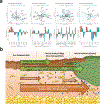Characterizing Dermal Transcriptional Change in the Progression from Sun-Protected Skin to Actinic Keratosis
- PMID: 36708948
- PMCID: PMC10293087
- DOI: 10.1016/j.jid.2022.12.021
Characterizing Dermal Transcriptional Change in the Progression from Sun-Protected Skin to Actinic Keratosis
Conflict of interest statement
Conflict of Interest Statement
The authors have no conflicts of interest to declare.
Figures


Similar articles
-
Quantitative fluorescence in situ hybridization measurement of telomere length in skin with/without sun exposure or actinic keratosis.Hum Pathol. 2014 Mar;45(3):473-80. doi: 10.1016/j.humpath.2013.10.009. Epub 2013 Oct 19. Hum Pathol. 2014. PMID: 24411948
-
Molecular discrimination of cutaneous squamous cell carcinoma from actinic keratosis and normal skin.Mod Pathol. 2011 Jul;24(7):963-73. doi: 10.1038/modpathol.2011.39. Epub 2011 Apr 1. Mod Pathol. 2011. PMID: 21743436
-
Gene expression patterns of normal human skin, actinic keratosis, and squamous cell carcinoma: a spectrum of disease progression.Arch Dermatol. 2010 Mar;146(3):288-93. doi: 10.1001/archdermatol.2009.378. Arch Dermatol. 2010. PMID: 20231500
-
Actinic keratoses.Cancer Treat Res. 2009;146:227-39. doi: 10.1007/978-0-387-78574-5_20. Cancer Treat Res. 2009. PMID: 19415207 Review. No abstract available.
-
Topical therapies for skin cancer and actinic keratosis.Eur J Pharm Sci. 2015 Sep 18;77:279-89. doi: 10.1016/j.ejps.2015.06.013. Epub 2015 Jun 16. Eur J Pharm Sci. 2015. PMID: 26091570 Review.
References
-
- Kim YS, Shin S, Jung SH, Park YM, Park GS, Lee SH, et al. Genomic Progression of Precancerous Actinic Keratosis to Squamous Cell Carcinoma. J Invest Dermatol 2021. - PubMed
Publication types
MeSH terms
Grants and funding
LinkOut - more resources
Full Text Sources
Medical
Molecular Biology Databases

